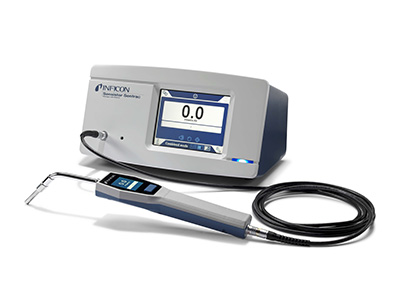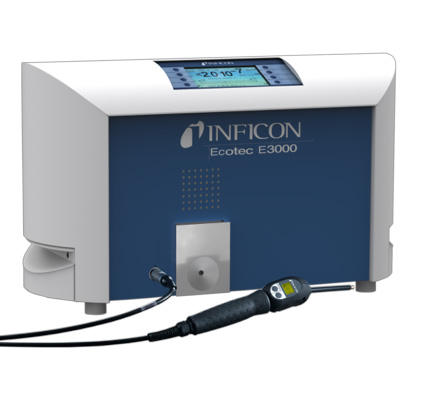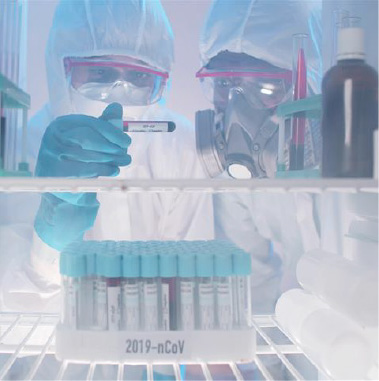Leak Testing of Ultra Low Temperature Freezers
Ultra freezers or ULT (ultra low temperature) freezers are often used in molecular biology and life science laboratories for the storage of biological samples such as DNA, RNA, proteins and vaccines. With the ongoing COVID-19 pandemic and the variety of e.g. RNA-based vaccines, the demand for ultra low temperature storage and transportation has increased significantly. Storage temperatures around -80°C (-112°F) must be maintained to avoid damage of any sample ingredients. Reaching the required temperatures ultra freezers are typically using cascade cooling systems. Those systems are commonly compressor-based systems consisting of two separate circuits with thermal connection by a cascade condenser. Typical refrigerants used in this application are R-23 or R-508b, R-22, ammonia, R-507 and R-404a, among others.
Description of Technical Challenge
Leaks in the refrigerant circuit can lead to costly downtime of the freezer or failure while storing important and expensive vaccines and medicine. Reliable and professional leak testing in production will allow detection and even locating of leaks, helping to reduce the risk of failures of the ultra freezer.
Admittedly, pressure decay, soap spray and use of cheap handheld service leak detectors approaches are straightforward methods frequently used in leak detection, but they do not meet the sensitivity requirements of finding leaks measured as loss of 0.5 g/a refrigerant equivalent in this case.
The INFICON Solution

The Sentrac Strix Edition Hydrogen Leak Detector allows leak detection down to the required leak rates
INFICON offers solutions for pre-testing before filling with refrigerant, and final testing of the cooling circuit once filling is completed.
Pre-testing with tracer gases ensures that only leak-tight cooling circuits will be filled with refrigerant, saving filling time and gas. This can be done with leak detectors of different levels. The INFICON portfolio includes the Sentrac® Strix™ Edition Hydrogen Leak Detector on an entry level, the Protec® P3000 Helium Leak Detector on a standard level and the XL3000flex Helium and Hydrogen Leak Detector on an advanced and flexible level. The Sentrac Strix Edition enables leak detection with diluted hydrogen as tracer gas down to the required leak rates. With the Protec P3000 and the XL3000flex leak detectors, leak detection down to 1E-7 mbar l/s is achievable (equal to 0.05 g/a for R134a) . While the Protec P3000 detects helium, the XL3000flex is able to detect both helium and hydrogen. This offers the use of an inexpensive and conventional forming gas consisting of 5% hydrogen in nitrogen, which is also used for applications with the Sentrac Strix Edition. All three instruments are equipped with a hand probe for easy leak locating with immediate feedback of any found leaks.

The Ecotec 3000 from INFICON is a multigas leak detector with a minimum detectable leak rate of 0.05 g/a for R134a
The Sensistor® ILS500 F HP is a tracer gas filler. This unit can be combined with both helium and hydrogen INFICON leak detectors. The ILS500 F HP has complete tooling and gas filling function eliminating the need for time-consuming manual tracer gas filling, improving test quality assurance. It comes with a range of features such as gross leak testing, blockage test and recipe handling. In the high-pressure version it allows tracer gas filling with pressures up to 30 bar.
Final testing of the refrigerant-filled cooling circuit can be carried out with the INFICON HLD6000 Refrigerant Leak Detector for halogen-based refrigerants with a minimum detectable leak rate down to 0.5 g/a, or with the INFICON Ecotec® E3000, which is a multigas leak detector with a minimum detectable leak rate of 0.05 g/a for R134a. Both leak detectors are likewise equipped with hand probes for locating leaks and direct feedback to the operator.
Advantages of Leak Testing with INFICON Leak Detectors
FACTS ABOUT FORMING GAS
The gas used for testing is a mix of 5% hydrogen and 95% nitrogen which is inexpensive, non-flammable (see ISO 10156), non-toxic, and environmentally friendly.
- Fast pinpointing of leak location, minimizes downtime and costs
- High sensitivity to locate the smallest leaks
- Safe, dry and clean method
For more information about how to effectively leak test ultra freezers contact us at reachus@inficon.com.
